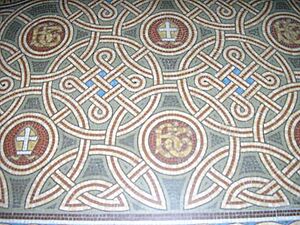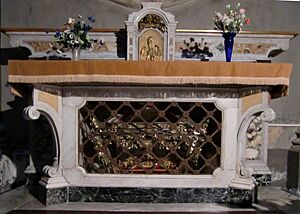Tadhg Mac Cárthaigh facts for kids
Quick facts for kids BlessedTadhg Mac Cárthaigh "Thaddeus McCarthy" |
|
|---|---|

Stained glass window of Blessed Thaddeus in Saints Peter and Paul's Church, Cork, created by Earley and Company
|
|
| Bishop | |
| Born | c. 1455 Innishannon , County Cork |
| Died | 25 October 1492 (aged 36–37) Ivrea |
| Venerated in | Roman Catholic Church |
| Beatified | 26 August 1895 by Pope Leo XIII |
| Major shrine | Cathedral of Ivrea, Cathedral of Saint Mary and Saint Anne in Cork, Ireland, Cathedral of Saint Colman, Cobh, Ireland, Church of Saint Mary, Youghal, Ireland |
| Feast | 25 October |
Tadhg Mac Cárthaigh (also known as Thaddeus McCarthy) was an important Irish church leader born around 1455. He became a bishop, but he faced many challenges. He was appointed to lead two different church areas, called "sees," but he was never able to take his place in either of them. His special day, called a feast day, is October 25.
Contents
Early Life and Education
Tadhg Mac Cárthaigh was born in 1455 in a place called Innishannon in County Cork, Ireland. His father was a powerful local leader, and his mother came from another important family. It's believed he was part of the MacCarthy Reagh family, a well-known branch in the area.
Tadhg likely received his early education from the Franciscan Friars in Timoleague. He continued his studies to become a priest with his uncle, Canon Thady Mac Cárthaigh. Later, he studied at Paris University and then traveled to Rome to continue his learning. Before becoming a bishop, he worked in one of the church courts in Rome.
Becoming Bishop of Ross
While Tadhg was in Rome, his good qualities impressed many people. Even though he was only 27 years old, Pope Sixtus IV chose him to be the Bishop of Ross in Cork. This position had become empty after the previous bishop died. On May 3, 1482, Tadhg was officially made a bishop in Rome.
However, when he returned to Munster, a region in Ireland, Tadhg found a problem. Another person, Hugh O'Driscoll, was already in charge of the Ross area. He had been appointed by the same Pope Sixtus earlier. At this time, Ireland was not united; it had many different rulers and powerful families. It's possible that the Pope had received wrong information about Bishop Hugh.
A long disagreement started between the Mac Cárthaigh and O'Driscoll families over who should be the rightful bishop. False accusations were made against Tadhg. Bishop O'Driscoll thought Tadhg was pretending to be the bishop and complained to Rome. In 1485, the new King of England, Henry VII, also wanted his own choice for bishop. Tadhg was declared an "intruder" and was even temporarily removed from the church (excommunicated).
In 1488, Pope Innocent VIII confirmed this decision. But Tadhg appealed, meaning he asked for a review of the decision. A special group looked into his case and found that he was innocent. His excommunication was canceled. Because of this, he was then appointed as the Bishop of Cork and Cloyne on April 21, 1490.
Challenges in Cork and Cloyne
When Tadhg returned to Munster again, he found another powerful leader, Gerald FitzGerald, had taken over the Diocese of Cork and Cloyne. Gerald had the support of local rulers and important families.
Armed men prevented Tadhg from entering the main church. For two years, Tadhg traveled from town to village. He carried official documents from the Pope that said he was the rightful bishop and that he was innocent of any charges. He didn't want his own family to fight back, so they eventually stopped supporting him. Without family support or safety, Tadhg decided to go back to Rome to ask the Pope for help again.
Pope Innocent XIII gave him another document in July 1492. This document ordered Gerald FitzGerald, who was one of the most powerful people in Ireland, to use his army to protect Tadhg and help him become the Bishop of Cork and Cloyne.
Fearing for his life from his enemies, Tadhg decided to travel back to Ireland disguised as a simple pilgrim.
His Journey and Death
About fourteen weeks later, Tadhg Mac Cárthaigh arrived in a town called Ivrea in Italy. He had likely walked all the way from Rome. On the evening of October 24, 1492, a tired pilgrim arrived at a place where travelers could rest. He was dressed in simple clothes and looked very weak. The person in charge of the hostel welcomed him and gave him a place to sleep.
At dawn, a strange, bright light was seen coming from his room. When the warden entered, he found the pilgrim's body glowing with a beautiful light. Tadhg Mac Cárthaigh was only 37 years old.
Normally, he would have been buried in a simple, unmarked grave. But the local bishop, Nicholas Garigliatti, was called. It is said that the bishop had a special dream that night. In his dream, he saw a man dressed in bishop's robes rising to heaven. He immediately recognized the dead pilgrim as the man from his dream.
They looked through the pilgrim's few belongings: a wallet, a water bottle, and a walking stick. Inside the wallet, they found official church documents from the Pope and a bishop's ring. Bishop Garigliatti ordered that Tadhg's body be dressed in bishop's robes and brought to the Ivrea Cathedral. He was given a special public viewing before being buried inside the cathedral. When news spread that a bishop had died while traveling in disguise, many people came to the cathedral for his funeral. He was buried there, and many good things, called miracles, have been linked to him.
Honoring Blessed Tadhg
Tadhg's tomb became a special place for people to visit and pray. In 1742, when his tomb was opened, his body was found to be perfectly preserved.
During the terrible famine in Ireland in 1847, the church leaders and people of Ivrea gave a lot of money to help the Irish victims. They also asked for more information about Tadhg Mac Cárthaigh. This was because the people of Ivrea greatly respected him, and many miracles were believed to happen through his prayers. This request made people in Ireland very interested in Tadhg. After a long study of his life, it was decided to ask the Pope to declare him "Blessed."
In 1896, Pope Leo XIII officially recognized the long-standing special honor given to "Blessed Thaddeus." In the same year, church leaders in Ivrea agreed to send important items (relics) belonging to Tadhg to the church areas of Cork & Ross and Cloyne in Ireland. These relics can now be found in several churches in Ireland, including Cork North Cathedral and Cobh Cathedral. His feast day, October 25, is still celebrated in the church areas of Ross, Cork, Cloyne, and in Ivrea, where he is buried.
Tadhg Mac Cárthaigh was given the special title "White Martyr of Munster." This title honors him because he suffered greatly in his mind and body, even though he was not killed for his faith.
Images for kids





